Exploring the Depths of Honolua Surfing Culture
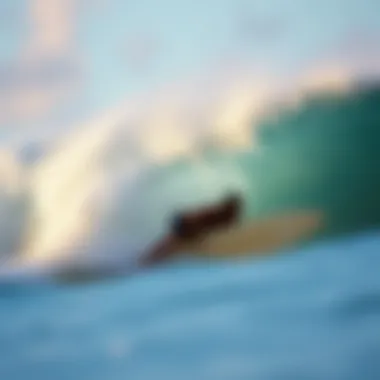
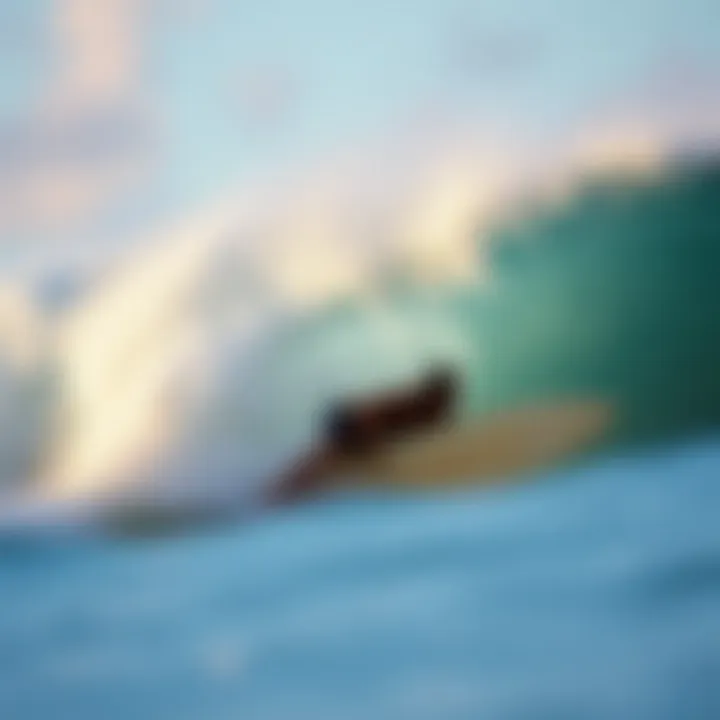
Intro
Honolua Bay, situated on the north shore of Maui, is not just a surfing destination; it’s a canvas of nature’s artistry. The bay is renowned for its clear, turquoise waters, lush greenery, and breathtaking cliffs that tower majestically over the surf. The unique geographical features of Honolua contribute significantly to the quality and character of its waves, making it a magnet for surfers of all stripes.
Every surfer, whether an eager novice or a seasoned pro, can find a sense of belonging in this vibrant community. Here, the ocean's rhythm becomes one’s heartbeat, and every wave presents an opportunity for connection and adventure. In this article, let’s embark on a journey that goes beyond just catching waves; let’s dive deep into the varied nuances of Honolua surfing, its cultural relevance, and the responsibilities that come with being a part of this extraordinary ecosystem.
Whether you’re drawn by the thrill of mastering a challenging break or the sheer joy of gliding atop gentle swells, understanding the intricacies of Honolua Bay will enrich your surfing experience. From practical tips and gear advice to essential safety measures and etiquette, we’ll cover it all in a way that honors the spirit of this beloved surf spot. So grab your board, and let’s paddle out.
Prelims to Honolua Surf
Surfing at Honolua Bay is more than just catching waves; it’s an experience that blends nature, culture, and community. This section introduces the captivating world of Honolua surfing, highlighting what makes this spot unique for surfers of all levels.
When one thinks of Honolua Bay, images of pristine waters and lush greenery often come to mind. The geographical features of this location contribute profoundly to its wave patterns and surfing conditions, making it a haven for water enthusiasts. The intricate relationship between the environment and surfing makes understanding these geographical elements vital for both novices and seasoned surfers as they prepare to navigate the waters.
Additionally, the historical context of surfing in this area provides essential insights into its cultural significance. Surfing has deep roots here, influenced by the traditions of the Hawaiian people. By looking back to how this sport evolved in Honolua, we can appreciate its current state and realize its importance beyond mere recreation.
As we dive deeper into Honolua's surfing intricacies, we will explore the geographical overview, which includes vital attributes of the bay’s landscape, and delve into the rich history that shapes the present surfing culture here. By comprehensively examining these elements, readers can grasp the essence of surfing at Honolua, ensuring they are well-informed and respectful of both the sport and the environment.
"Surfing is not just about the ride; it’s about the journey that brings us closer to nature and our own selves."
As the tides change, so too do the stories and experiences found at Honolua Bay, making this an endless source of exploration, learning, and respect for the craft of surfing.
Wave Patterns Throughout the Year
Understanding the fluctuations in wave patterns at Honolua Bay is essential for any surfer, whether you’re just starting out or you’ve paddled out more times than you can count. Wave patterns dictate not just the surfing conditions, but they are a reflection of environmental factors that affect anything from tide levels to wind direction. It's crucial to grasp how these waves behave throughout the year to enhance your surfing experience and safety.
Understanding Wave Mechanics
To understand the wave patterns at Honolua, we need to appreciate the mechanics behind them. Waves are generated primarily by wind and can vary greatly in height, length, and frequency based on several factors, including:
- Wind speed and duration: Strong winds over a long period generate larger swells.
- Fetch distance: The distance the wind travels over water affects wave height.
- Ocean floor geography: Bathymetry plays a significant role in how waves break.
At Honolua Bay, the waves can transform from gentle ripples to formidable walls of water depending on these variables. Recognizing the interplay between these elements helps surfers predict what to expect and choose the best time to hit the water.
Seasonal Variations
Summer Swells
Summer in Honolua is marked by swells that typically come in from a south-southwest direction. These waves tend to be more forgiving and often have a softer break. Perfect for beginners, the low height and moderate frequency offer an excellent opportunity for novices to get accustomed to riding waves without the intimidation of towering surf.
- Characteristics: The summer swells create a more mellow atmosphere, ideal for getting the hang of paddling, balancing, and catching waves. Generally, they range between two to four feet, making rides both enjoyable and less risky.
- Benefits: For those looking to refine their skills, these conditions provide ample chances to practice turns, carve through each wave, and experience the thrill of catching a wave in a relatively safe environment.
- Unique features: However, the downside is that during summer months, these swells can sometimes lack the consistency that more experienced surfers look for. You might find quieter sessions with fewer people in the water, but the waves might not always cooperate with your plans.
Winter Consistency
Come winter, Honolua Bay undergoes a significant transformation. The north swells, driven by powerful weather systems in the Pacific, create more challenging conditions that draw in experienced surfers from all over the globe. Winter waves can typically reach heights exceeding ten feet.
- Characteristics: Unlike summer, these winter waves are fast, powerful, and require a higher skill level to navigate safely. The consistency in swells during this season ensures plenty of action for those ready to take on the challenge.
- Benefits: The thrill of tackling larger waves is irresistible for many surfers, offering ample opportunities for spectacular rides and jumps. For seasoned surfers, each wave can be a canvas for unleashing advanced techniques and maneuvers.
- Unique features: Nonetheless, winter surfing demands a careful approach since conditions can shift rapidly. Strong currents and larger wave sizes can pose increased risks, making it imperative to be aware of one’s limitations and respect local conditions.
Surfing winter bombs at Honolua is not just a test of skill; it’s a rite of passage for serious surfers.
Cultural Significance of Honolua Bay
Honolua Bay stands as a beacon of surf culture and indigenous heritage. Its waters are more than just a playground for surfers; they are a tapestry woven with stories, traditions, and community ties. The bay holds a special place in the hearts of both local surfers and visitors alike, making this cultural significance paramount.
Surfing here is not merely a sport; it resonates deeply with the identity of the local people. The patterns of the waves, the rhythm of the tides — all echo a history that spans generations. Anyone who steps onto a board here is partaking in something larger than themselves. That connection to the past infuses each ride with a deeper meaning.
Indigenous Connections
The indigenous people of Hawaii, known as the Kanaka Maoli, have long revered Honolua Bay. For them, the ocean is sacred, a provider of sustenance and a space for spiritual connection. The bay's waters once served as a fishing ground, integral for survival. Today, it symbolizes resilience and continuity of ancient ways.
Moreover, traditional practices like heʻe nalu (surfing in Hawaiian) link modern surfers to indigenous customs. Learning about these practices sets a context for the sport; it’s no longer just about riding waves but about honoring the land and its history.
This relationship is highlighted during various cultural festivals, where surfing is celebrated alongside traditional hula and music. The tales told during these events reflect the 'Aloha Spirit,' encapsulating the values of respect, love, and community.
"Surfing at Honolua isn’t just about personal triumph; it's about community and culture.”
Impact on Local Surf Culture
Honolua Bay has undoubtedly shaped the local surf culture. As one of the most picturesque surf spots on the island, it draws both seasoned professionals and enthusiastic novices. This influx creates a blend of experiences and perspectives, fostering a vibrant, engaging surf community.


The camaraderie found in this community extends beyond the waves. Local surf schools often train newcomers, blending techniques with the area's rich history. Here, instructors emphasize respect for the ocean and environment, ensuring that the ethos of surfing is passed on to the next generation.
In addition to the training, local organizations frequently hold surf competitions and community clean-ups. Such events promote environmental stewardship and camaraderie among surfers. These gatherings not only enhance the local surf culture, but they also maintain the natural beauty of the bay, further intertwining the act of surfing with deep-seated cultural values.
Honolua Bay is more than just a surf spot; it is a cultural epicenter where tradition meets modernity. Both locals and travelers experience the seamless blend of nature, heritage, and sport — an experience that defines the essence of surfing in this iconic location.
Surfing Skill Levels
Surfing at Honolua Bay appeals to a diverse group of surfers, from those just getting their feet wet to seasoned wave riders looking for their next challenge. Understanding the various skill levels in surfing can greatly enhance one’s experience, making it more enjoyable and safe. It’s not just a matter of ability; different skill levels also dictate what to expect from the waves, the risks involved, and the best practices to follow.
Beginners' Guide to Honolua
Essential Techniques
For those brand-new to surfing, mastering essential techniques is crucial. These techniques focus on the fundamentals of riding a wave and controlling the surfboard. A standout characteristic of these techniques is their emphasis on balance and paddle efficiency. Novice surfers will benefit from practicing how to position themselves on the board, how to paddle effectively, and how to pop up correctly. Learning this foundational set ensures that beginners can navigate the water without fear.
The unique feature of these essential techniques lies in their adaptability—beginners can apply them to various surf conditions, especially in the gentle swells often found at Honolua. However, one should note that learning these techniques may take time and patience, as it can be challenging to master the art of balance in the water, especially for those who may not have prior experience with similar sports.
Safety Tips
When venturing into the surf, safety tips cannot be overlooked. They serve as an entry point into understanding the ocean’s unpredictability, especially for new surfers. Key aspects of safety tips include being aware of local conditions and recognizing potential hazards like riptides or rocky areas around Honolua Bay. These tips not only promote the safety of the surfer but also enhance the overall surfing experience by preventing accidents.
One notable feature is that these safety recommendations are universal but tailored to the unique features of Honolua. Understanding local currents, recognizing wave patterns, and using the buddy system can prevent mishaps. The downside to ignoring safety can be severe; a lack of caution can quickly turn a fun surfing session into a perilous situation, highlighting why these tips are non-negotiable for anyone looking to enjoy the surf.
Advanced Techniques for Experienced Surfers
For surfers who've honed their skills, advanced techniques become the next frontier. These include maneuvers such as carving, aerials, and tube riding that require both confidence and precision. Experienced surfers understand that these techniques not only elevate their performance but also deepen their connection with the ocean. By pushing their limits, they can explore the full potential of waves at Honolua and continuously adapt their styles to surf conditions.
Necessary Gear for Surfing at Honolua
Surfing at Honolua is not just an adventure; it’s a blending of nature, skill, and the right gear. When the waves are calling, having the appropriate equipment makes all the difference. The swells can be fierce, and each surfer’s experience varies, making it crucial to have the right tools at your disposal.
A well-thought-out selection of gear not only enhances your performance but also ensures safety, comfort, and enjoyment. From surfboards to wetsuits, here's a breakdown of what you should consider essential when preparing for your day in the water.
Types of Surfboards
Shortboards
Shortboards, those sleek, maneuverable beauties, are often a top choice for many surfers looking to catch the fast, powerful waves of Honolua. Typically ranging from 5 to 6.5 feet, their design encourages agility, allowing for sharp turns and radical aerial maneuvers. One thing about shortboards is they often feature a pointed nose, which aids in cutting through water efficiently.
"When you’re looking to ride the steepest waves, nothing beats the quick response of a shortboard."
Their lightweight structure facilitates easy paddling and quick takes off, making them ideal for experienced surfers. However, they can be somewhat tricky for beginners, as balance and paddle strength are necessary for a successful ride. You could end up spending more time in the water than on the board at first!
Longboards
On the flipside, longboards provide a different experience entirely. With lengths usually over 8 feet, they embody stability and ease. The rounded nose and wider body allow surfers to catch waves sooner, making them a fantastic option for less experienced individuals.
Longboards encourage a laid-back, cruisey vibe, often associated with classic surfing styles. They’re perfect for riding smaller, rolling waves often seen in the summer. However, paddling can be a workout, and their size makes them less agile in bigger swells. For many, the joy of longboarding lies in the smooth rides and graceful style it brings to the sport.
Fish Varieties
Fish surfboards are like the best of both worlds, combining elements of short and longboards. Their unique shape, often featuring a swallowtail, provides a wider surface area that captures water brilliantly, thereby enhancing stability and speed even when waves are not at their peak.
Ideal for surfers looking to ride smaller, choppier waves, fish boards can be an exhilarating ride. They’re highly versatile, making them popular among a variety of surfers. However, they sometimes lack the responsiveness of a classic shortboard, especially when trying to achieve tighter turns or aerial tricks.
Essential Surf Accessories
When surfing in Honolua, having the right accessories can vastly improve your overall experience. Beyond the surfboards, here’s a look at other items that shouldn't be overlooked in your surf kit.
Wetsuits
Wetsuits are essential for maintaining your body heat in the cooler waters of Honolua. They are designed to insulate your body while allowing flexibility for movement. The thickness of the wetsuit will depend on the time of year; during the winter months, a thicker suit is advisable, whilst lighter suits are preferable in the summer.
A key characteristic of the wetsuit is its neoprene material, which traps a thin layer of water between your body and the suit, keeping you warm as your body heat warms that water. This extra layer of warmth can make those chilly morning sessions more bearable and enjoyable.
Leashes
A leash, often overlooked, is a small yet crucial piece of equipment. Surf leashes connect you to your board, preventing it from drifting away when you wipe out. A well-fitted leash not only saves your board but also protects other surfers from potential hazards of a runaway board.
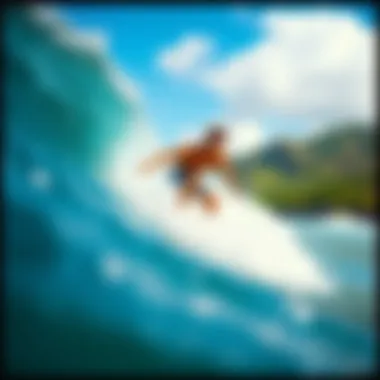
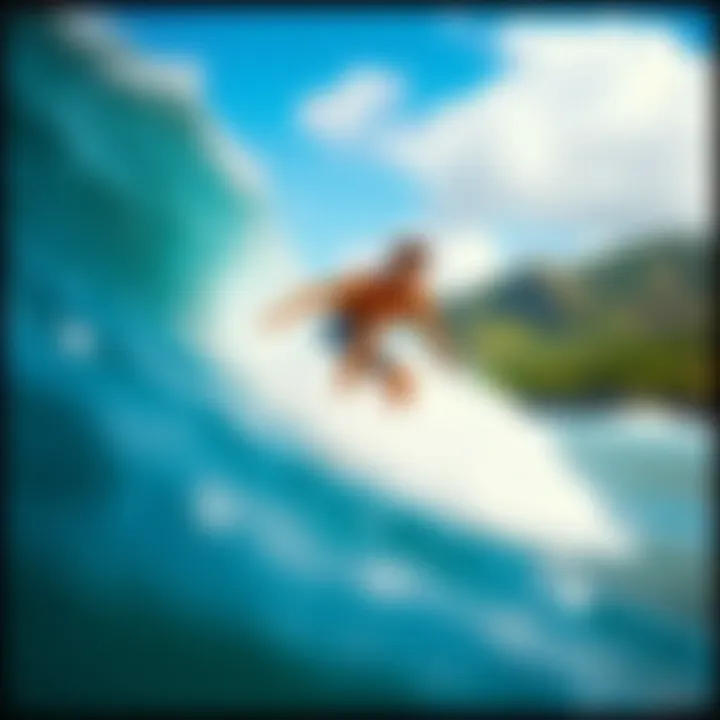
Most leashes come with a cord, which varies in thickness and length depending on surf conditions. It is an accessory that contributes a great deal to safety in the water, allowing you to keep your gear close while focusing on riding those gleaming waves.
Surf Wax
Last but not least is surf wax, a simple but vital tool. You apply it to the top of your board for grip; without it, your feet might slide off unexpectedly as you try to get into position. Different temperatures of wax are available, enabling you to choose based on the surface conditions of the water.
Using surf wax correctly enhances your performance, ensuring that you have solid footing as you navigate the waves. It's a small detail that can lead to bigger successes on the board.
Safety Considerations
When surfing at Honolua, ensuring one's safety is not simply advice; it's a necessity for an enjoyable experience. The idyllic waves and breathtaking landscapes may entice surfers of all levels, but the ocean's temperament can change in the blink of an eye. Neglecting safety measures can lead to unfortunate incidents that mar the sport's allure.
Understanding Local Conditions
Every surfer must have a firm grasp of local surf conditions before hitting the waves. At Honolua, this involves acknowledging the geographical features that shape its waves. With sharp reefs and rocky outcroppings, knowing where to paddle out is crucial.
- Tides and Currents: The tide significantly affects surf conditions. During high tide, waves can become unpredictable due to rapid water movement. Conversely, low tide tends to expose more reef, which can result in a thrilling yet hazardous environment. Surfers should constantly monitor tides via local tide charts and adjust their surfing times accordingly.
- Winds: Wind direction and intensity can drastically alter wave quality and safety. Offshore winds are generally ideal, creating cleaner, more rideable waves. However, when the wind is onshore, it can lead to messy waves, hampering a good surfing experience.
- Wave Size and Break: Understand the specifics of how waves break at Honolua. Certain sections may have hollow, steep waves that can be challenging even for seasoned surfers. A comprehensive assessment of wave size and behavior helps make informed decisions regarding when and where to surf.
Knowing these local conditions can be the difference between a sublime session and a perilous encounter. Surfers should never hesitate to ask locals about the day's conditions, as firsthand knowledge can illuminate potential dangers.
Emergency Procedures
A vital aspect of surfing is being prepared for emergencies, as they can and do occur. In Honolua, where stunning beauty meets unpredictable nature, having an emergency plan can save lives. Below are essential steps every surfer should keep in mind:
- Know Emergency Contacts: As a surfer at Honolua, it is crucial to have emergency numbers at hand, such as local rescue services or lifeguard stations. A quick call can be a lifeline if you or someone else gets into trouble.
- Identifying Risks: Familiarize yourself with potential dangers at the location, such as rip currents or sharp coral. Knowing areas to avoid can prevent accidents. If caught in a rip current, the best approach is to swim parallel to the shore until free from its pull.
- First Aid Knowledge: Basic first aid training can be invaluable. Knowing how to treat cuts or to recognize signs of shock can make a difference in emergencies. Having a first aid kit accessible can also serve as a proactive measure.
"Preparedness is a virtue that echoes through the waves. The ocean respects those who respect it."
- Rescue Operations: In the unfortunate event of an accident, it is important for surfers to understand the difference between self-rescue and needing assistance. If someone is spotted in distress, alerting nearby surfers or lifeguards takes priority.
By incorporating these considerations into your surfing practice, you not only enhance your own safety but also that of fellow surfers. In Honolua's beautiful yet unpredictable waves, respect for the ocean and its conditions is paramount.
Etiquette and Respect in Surfing
Surfing is not just a sport; it’s a culture that embodies camaraderie, respect, and understanding. At Honolua Bay, where surfers from all walks of life converge, etiquette and respect play a crucial role in ensuring everyone enjoys their time on the water. In the end, it’s all about sharing the waves and fostering a sense of community among those who love surfing.
Understanding Lineups
When you paddle out at Honolua, one of the first things you’ll notice is the lineup—a term used to describe where surfers wait for their turn to catch waves. Understanding the dynamics of the lineup is vital for surf etiquette. An orderly lineup ensures a fair experience for all surfers, preventing collisions and misunderstandings.
Here are some important points to consider while getting familiar with the lineup:
- Positioning: Always take a spot that respects the rules of priority. Surfers closer to the peak of a wave have the right of way. If you’re further down the lineup, give way to those who are closer to the break.
- Communication: If you see someone approaching a wave, a simple shout or hand signal can alert others of your intentions. Also, keeping conversations to a minimum while waiting is essential—it helps with focus and gives everyone a chance to catch a wave without distractions.
- Patience: It’s easy to get caught up in the excitement, but patience is vital. Waves come and go, and getting frustrated can lead to risky decisions. Respect the ocean and each other’s turns.
"Surfing is about finding your rhythm with nature and people. Respecting the lineup is the first step to syncing with everything around you."
Respect for Other Surfers
In any surf community, respect is the glue that holds everything together. At Honolua, it's essential to acknowledge and appreciate the surfers around you. Here are some considerations to keep in mind:
- Lifelong Learners: Understand that everyone is at different skill levels. A beginner might struggle with paddling or reading the waves, but they still deserve the same opportunity to enjoy the water. Help out where you can but do not monopolize waves.
- Body Language: Often, it’s the unspoken communication that matters most. Look for cues from fellow surfers to gauge their intentions. Keep a friendly demeanor, and if your path crosses someone else’s, a nod or smile can go a long way.
- Leave No Trace: Respect for the ocean extends beyond the surf itself. Clean up after yourself, whether it's packing out trash or not leaving your surf wax behind. Help maintain the beauty of Honolua, for its charm is a shared treasure.
In summary, practicing etiquette and respect while surfing at Honolua Bay not only creates a harmonious atmosphere but enriches your experience as well. When everyone adheres to these principles, it enhances the ride for all. Surfers become stewards of the ocean and each other, promoting a culture that honors tradition while embracing growth.
Environmental Conservation Efforts
Surfing is not just a sport; it's an experience deeply intertwined with nature. At Honolua, the waves and the landscape come together to create a haven for surf culture. However, this beauty is fragile, and that’s where environmental conservation efforts play a crucial role. Protecting the ocean and coastal ecosystems ensures that future generations can enjoy the breathtaking surf of Honolua as much as we do today.
Sustainability Practices
Sustainability is the name of the game when it comes to preserving the natural beauty of Honolua Bay. This includes a mix of everyday choices surf enthusiasts can make. Here are some pivotal sustainability practices:
- Eco-Friendly Surfboards: Some companies are now producing surfboards from recycled materials or sustainable wood. This not only reduces waste but also supports a greener surf culture.
- Biodegradable Wax: Switching to plant-based surf wax minimizes plastic waste. Every tiny effort counts, and surfers are starting to take notice.
- Waste Management: Local initiatives encourage surfers and beachgoers to dispose of their trash responsibly. "Leave nothing but footprints, take nothing but memories" often resonates with regulars here.
By adopting these practices, surfers can minimize their impact on the local ecosystem.
Community Initiatives
Within the Honolua surfing community, a wave of change is stirring, led by passionate individuals and organizations keen on protecting the environment. These community initiatives serve as pillars for conservation efforts:
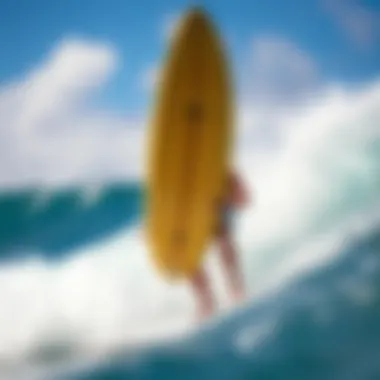
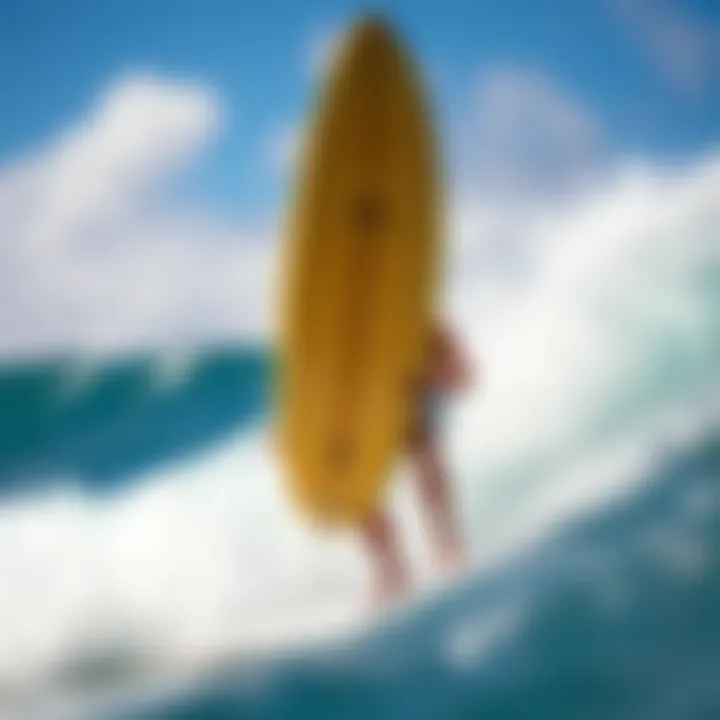
- Beach Clean-Ups: Regularly organized clean-up events bring surfers and locals together to clear debris from the beaches and ocean. It fosters a sense of community while actively contributing to a cleaner environment.
- Educational Workshops: Many local surf schools offer workshops that focus on environmental awareness. Teaching surfers about the importance of marine life and ecosystems helps promote good stewardship.
"When you love a place, you want to protect it. Our surfing family understands that working together leads to a healthier ocean for everyone."
Such initiatives reflect a collective commitment, reminding us that honoring nature while enjoying the surf is both a privilege and a responsibility.
Local Surf Community and Events
In the world of surfing, one of the most remarkable aspects is the sense of community that envelops it. This is particularly true in Honolua, where surfers and ocean enthusiasts come together, not just to ride waves, but to foster enduring friendships and shared experiences. Local surf communities in places like Honolua are vital for several reasons, including the nurturing of a collaborative spirit, the promotion of local culture, and the initiation of several events throughout the year, which ultimately enhance the surfing experience for both novices and seasoned riders.
Annual Surf Competitions
Honolua Bay hosts a variety of annual surf competitions that draw local talent and visitors alike. These events are more than just contests; they serve as a platform for surfers to showcase their skills while also encouraging camaraderie among participants. Events like the Honolua Bay Surf Challenge have gained popularity, featuring categories ranging from amateur to professional levels.
- Showcasing Talent: Competitions offer surfers the chance to strut their stuff in front of judges and crowds, which can often lead to sponsorships and career opportunities.
- Building Community: Beyond competition, these events provide a gathering space for surfers to meet, swap stories, and forge bonds that can last a lifetime.
- Cultural Significance: Many competitions include cultural elements, such as local music and food stalls, which help reinforce the connection between surfing and Hawaiian culture.
"Surfing can often feel like a solitary sport, but the community events at Honolua remind us that we are all riding the same wave together."
Surfing Workshops and Clinics
In addition to competitions, Honolua offers various surfing workshops and clinics designed to enhance skills and knowledge among surfers of all levels. These workshops are typically conducted by experienced instructors who share valuable insights into the local waves, weather conditions, and surf etiquette. They are an excellent way to nurture the next generation of surfers while providing seasoned surfers with fresh perspectives.
- Skill Development: Workshops range from beginner-level sessions focusing on fundamentals to advanced techniques for experienced surfers looking to refine their craft.
- Safety Education: Many clinics emphasize safety—teaching participants about recognizing potential hazards and understanding ocean currents.
- Community Engagement: These events foster inclusivity, encouraging surfers from different backgrounds to join forces and learn, promoting diversity within the surf community.
For more information on upcoming events, check local resources like Hawaiian Surfing Association and community forums on platforms like Reddit.
Whether you are looking to compete, learn, or just soak in the vibrant culture of Honolua, the local surf community stands ready to welcome all who share a love for the ocean.
Travel and Access to Honolua
When it comes to surfing at Honolua Bay, getting there is as vital as riding the waves. The ease of travel can significantly enhance the overall experience—turning what could be a challenge into an adventure filled with excitement. Not only does good access to the surf improve convenience, but it also allows you to maximize your time riding the swells. Understanding your options for getting to Honolua, as well as where to stay, can make all the difference for your surfing trip.
Transportation Options
Getting to Honolua Bay involves planning ahead, especially if you're unfamiliar with Maui's layout. The best place to start is Kahului Airport (OGG), which is the main hub for air travel on the island. From there, you’ll typically need a car to navigate to Honolua. While public transport exists, it may not cater directly to surfers' needs, leaving many with the option of renting a vehicle.
Here’s a closer look at your transportation choices:
- Rental Cars: The most flexible option. You can choose the type of vehicle that suits your needs, whether it’s a compact car for easier parking or an SUV for more gear.
- Taxis and Rideshares: Services like Uber or Lyft are available in Maui, but the costs can quickly add up, especially if you’re making multiple trips to the beach.
- Shuttle Services: Several companies offer shuttle services from the airport to various hotels and resorts. This could be cost-effective for larger groups.
- Bicycle Rentals: For the more adventurous, biking can be a fantastic way to explore the area. It allows for a unique perspective while enjoying the island’s scenery.
In all these cases, planning your journey in advance is key. Surfboards and beach gear can take up a good amount of space, so make sure your transportation option accommodates your needs.
Accommodation Recommendations
After arranging your trip to Honolua, the next step is finding a place to hang your hat. Having a nearby base will not only provide comfort but also make early morning surf sessions feasible. There are different types of accommodations available to suit various preferences and budgets. Here are some recommendations:
- Hotels and Resorts: For a touch of luxury, options like the Ritz-Carlton Maui in Kapalua provide stunning views and easy access to the beach, along with world-class amenities.
- Vacation Rentals: Often more spacious than standard hotels, rentals from platforms like Airbnb or Vrbo can offer all the comforts of home. Consider a house or condo near Kapalua Bay for more privacy and a relaxed atmosphere.
- Hostels: If you’re on a tighter budget, check out local hostels. They not only offer economical options but often facilitate conversations with fellow surfers, fostering connections and camaraderie.
- Camping: For the intrepid surfer, camping is a thrilling option. The nearby Mala Wharf offers camping facilities with direct ocean access. Just ensure you bring all necessary gear, as amenities may be limited.
Regardless of where you choose to stay, make it a priority to book in advance, especially during peak surfing season. The sooner you lock down your accommodations, the better your chances of finding a place that meets your needs.
"The journey is as important as the destination."
Planning your travel and access to Honolua is not just about logistics; it’s about crafting an experience. With the right transportation and accommodation, surf adventurers can focus more on the waves ahead and less on the hassle of getting there.
Future of Surfing at Honolua
The future of surfing at Honolua holds significant importance not just for local surfers, but also for the broader surfing community. As the sport evolves, so do the practices and expectations surrounding it. With the advancements in technology, changing cultural attitudes and a growing focus on environmental sustainability, the direction that Honolua surfing takes can set a precedent for other surf spots around the globe.
Trends in Surfing
Surfing at Honolua is witnessing an array of trends that reflect the transformation in how the sport is approached and practiced. One prominent trend is the increasing popularity of sustainable surfing practices. This means that surfers are now more aware of the materials they use, often opting for eco-friendly surfboards and gear. Here are a few notable shifts:
- Eco-Friendly Boards: Manufacturers are now creating boards from sustainable materials, minimizing environmental impact. Brands like Firewire and Sustainable Surf emphasize the use of recycled materials.
- Inclusivity: More female surfers and people from different backgrounds are taking to the waves, promoting a rich community culture at Honolua.
- Youth Engagement: Schools and community classes are focusing on teaching younger generations, not just how to surf but also about ocean conservation and respect for nature.
The waves might change, but the commitment to the ocean’s future remains constant.
As these trends take shape, it transforms the experience at Honolua. Surfing isn’t just about riding waves; it’s intertwined with understanding ocean stewardship.
Emerging Technologies in the Sport
In recent years, innovations have made a significant mark on surfing, enhancing both the experience and performance. At Honolua, several emerging technologies are shaping the future of the sport:
- Wearable Tech: Devices like smartwatches and surf-specific trackers provide surfers with valuable data regarding their performance, wave counts, and even health metrics while on the water.
- Virtual Reality Training: Some surf schools are now incorporating virtual reality to give beginners the feel of surfing before they hit the waves, making the learning process far less intimidating.
- AI in Surf Forecasting: Advanced algorithms are becoming crucial in analyzing wave patterns and predicting optimal surfing conditions, helping surfers choose the best times to hit the water.
These innovations promise to not only enhance the surfing experience but also make it safer and more accessible for newcomers. The combination of technology with the inherent unpredictability of the ocean will dictate how surfing is approached, particularly at a location as dynamic as Honolua.















